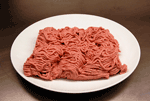 Recent media hype, by a select few, has drawn an outcry of attention to food safety concerns – concerns that the beef industry is struggling to defend. The challenge for the 2 percent of the population (agriculture) that feeds the world is to provide safe and healthy food. This is difficult to do with the scrutiny of ignorant outsiders. They judge sound and regulated practices and then sensationalize the issue (pouring ammonia on steak). They add colorful vocabulary to stimulate their issue's appeal. (I won't add to the fodder in this blog by using their terms.)
Recent media hype, by a select few, has drawn an outcry of attention to food safety concerns – concerns that the beef industry is struggling to defend. The challenge for the 2 percent of the population (agriculture) that feeds the world is to provide safe and healthy food. This is difficult to do with the scrutiny of ignorant outsiders. They judge sound and regulated practices and then sensationalize the issue (pouring ammonia on steak). They add colorful vocabulary to stimulate their issue's appeal. (I won't add to the fodder in this blog by using their terms.)Lean finely textured beef (LFTB) is 100 percent USDA-inspected beef. Repeat. . . Lean finely textured beef (LFTB) is 100 percent USDA-inspected beef. It is not a filler. Fillers would include cereals, legumes, vegetable, roots, and tubers. LFTB is the beef trimmings from roasts and steaks, just with fat attached. LFTB is not subpar, not from the cutting floor, and is not a pet food-only product as some media outlets incorrectly report.
That first swing is viewed as the truth. It is in defending yourself (the second swing per se) where finger-pointing and blame can be assigned. The beef industry has produced videos and sent press releases to outlets in the hopes of educating consumers on lean finely textured beef. However, the media blitz from one national television network had trumped all other major network coverage three-fold and continues to scare consumers.
The company at the center of the issue is Beef Product, Inc. (BPI) which announced that it would suspend operations at three of its four plants in Kansas, Texas, and Iowa. They are not shutting down . . . they are waiting for the dust to settle. They are continuing to pay full salaries and benefits to their employees at these three plants. They believe in their product and their people. In fact, the International Association for Food Protection gave its highest award (only one given each year) to BPI just five years ago. Food safety and quality was a priority then and remains so now.
Schools districts will now have the option to receive meat products without LFTB from USDA. Those products will come at a higher cost because a replacement for LFTB will be more expensive. Who will pay for that increase? Consumers are being encouraged to talk to their grocery stores about purchasing LFTB. And as we know, consumers carry a big stick – the checkbook. And when grocery stores or restaurants no longer carry LFTB products, how high will the consumers' bills increase?
I am sure there are people who have heard bits and pieces from the news and have sworn off any meat. That not only affects beef producers, it affects dairy producers, because we are beef producers, too. Over 1.5 million more head of cattle will need to be raised to account for the shortfall if LFTB is not used in the meat industry. That means more cattle (on the same amount of land), more feed will need to be grown, even higher feed prices, all in order to meet the "demands" of today's misinformed consumer.
Learn more about lean finely textured beef so you can speak up for your industry.
Click here for facts about LFTB from the MeatSafety.com website.
Top 8 Myths from the "beef is beef" website are found here.
A meat scientist's technical explanation of the process of producing lean finely textured beef is found here.The second video below also has a microbiologist talking about LFTB.
From the American Meat Institute:










